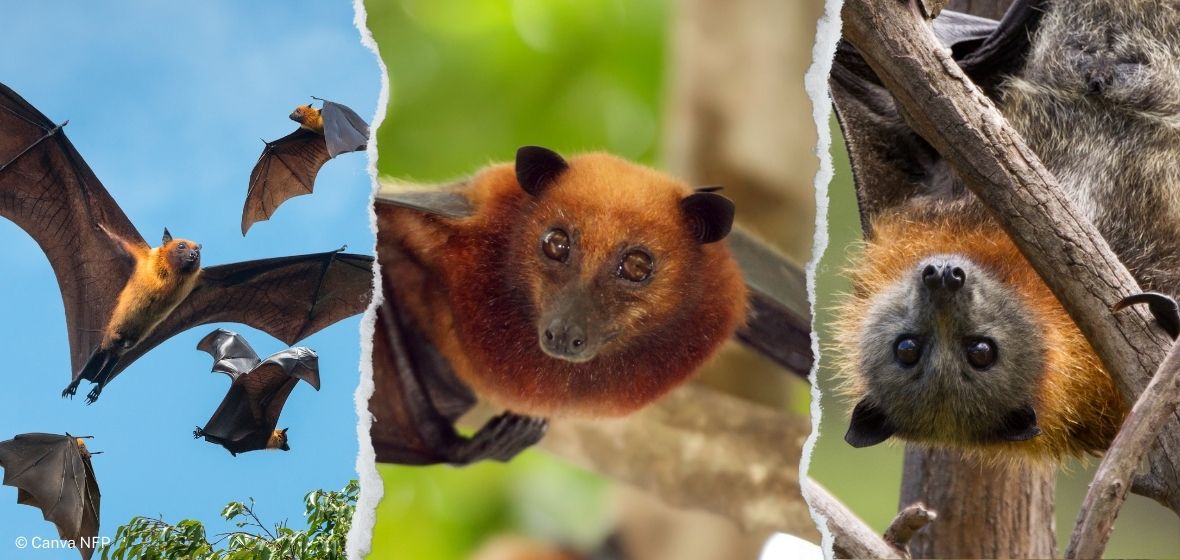
27 September 2023
September was Biodiversity Month — a month dedicated to promoting the importance of biodiversity through awareness, conservation, and sustainable practices. Flying-foxes, also known as fruit bats, stand as the unsung biodiversity heroes.
Extraordinary members of the animal kingdom
These intelligent, sentient mammals bring life to our forests and keep the ecological balance intact. But as they face numerous challenges, including habitat loss and human conflicts, it’s important to recognise their vital contributions to our environment.
Flying-foxes are the largest flying mammals in the world and are native to Australia. They are vegetarians who forage on the fruit of over 50 native rainforest trees and vines. Their excellent vision and keen sense of smell help them navigate their way over vast landscapes.
All four species of flying-foxes are found in Queensland:
- black flying-fox (Pteropus alecto)
- little red flying-fox (Pteropus scapulatus)
- spectacled flying-fox (Pteropus conspicillatus)
- grey-headed flying-fox (Pteropus poliocephalus).
How flying-foxes help preserve Queensland’s biodiversity
Seed Dispersal: Flying-foxes are important seed dispersers. They feed on a variety of fruits and nectar from native plants, and as they fly from tree to tree, they drop seeds along their flight paths. Each flying-fox can spread up to 60,000 seeds across a 50-kilometre stretch of land in one night. This helps in the regeneration and spread of native plants, contributing to the diversity of plant species in the region. Some plant species have co-evolved with flying-foxes, relying on them for seed dispersal.
Pollination: Flying-foxes are effective pollinators of many plant species as they transfer pollen while feeding on nectar, promoting the reproduction of these plants. This is essential for maintaining healthy plant populations and ensures the availability of food resources for other wildlife. They pollinate the flowers of over 50 native trees.
Ecosystem Health: By maintaining healthy plant populations and promoting the growth of diverse plant species, flying-foxes indirectly support a wide range of other wildlife. Many animals rely on the fruits and nectar produced by these plants as a food source, and the availability of these resources contributes to overall ecosystem health.
Genetic Diversity: The movement of flying-foxes across different areas can facilitate gene flow between plant populations, helping maintain genetic diversity. This genetic diversity is important for the adaptation and resilience of plant species in the face of environmental changes and threats.
Scavenging Role: Flying-foxes also play a role in cleaning up fruit and nectar that fall to the forest floor. This helps prevent the build-up of rotting fruit, which could otherwise attract pests or pathogens that could harm plant populations.
Threats push vulnerable species to the edge
It’s important to note that while flying-foxes provide these ecological benefits, they face various threats, including:
- habitat destruction
- colony disturbance
- backyard drape netting
- barbed wire entrapment
- car hits
- dog attacks
- electrocution
- natural predation
- seasonal food shortages.
Flying-foxes give birth to only one baby each year. Therefore, their populations are slow to recover from human persecution and natural disasters. Grey-headed flying-foxes are listed as vulnerable nationally (Environment Protection and Biodiversity Conservation Act 1999), and their populations have declined by one-third in the past ten years.
Conservation efforts are essential to protect these critical species and ensure their continued contribution to Queensland’s biodiversity. Balancing conservation needs with human concerns is a complex challenge that requires careful management and education to promote coexistence.
What you can do
- Join our Batty Boat Halloween Cruise on 29 October to celebrate all things batty with Wildlife Queensland and Bat Conservation and Rescue Qld: BOOK TODAY.
- Visit our shop and purchase the picture book Saving The Flying Fox: A Precious Forest Pollinator or a flying-fox soft plush toy to help us protect and conserve Queensland’s wildlife and their habitats.
